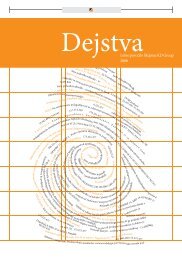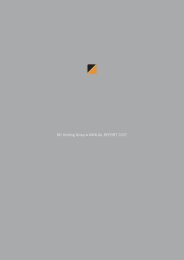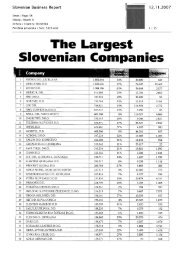The Group KD Group and KD Group dd
The Group KD Group and KD Group dd
The Group KD Group and KD Group dd
Create successful ePaper yourself
Turn your PDF publications into a flip-book with our unique Google optimized e-Paper software.
<strong>The</strong> <strong>Group</strong> <strong>KD</strong> <strong>Group</strong> Annual Report 2009<br />
Notes to Consolidated Financial Statements as at <strong>and</strong> for the year ended 31 December 2009<br />
2.6 Investment property<br />
Investment property is property (l<strong>and</strong> or a building, or part of a building, or both) held to earn rentals <strong>and</strong>/or for capital<br />
appreciation or both, rather than for administrative purposes or sale in the ordinary course of business. Investment property is<br />
initially measured at cost. After initial recognition, investment property of the <strong>Group</strong> is carried at its cost less accumulated<br />
depreciation <strong>and</strong> accumulated impairment losses, if any (cost model), i.e. the same as property, plant <strong>and</strong> equipment. <strong>The</strong><br />
<strong>Group</strong> reviews once a year the proportion of investment property obtained by other companies in the <strong>Group</strong> under lease<br />
agreements; in the consolidated balance sheet, the value of investmet property is recognised within the items of property,<br />
plant <strong>and</strong> equipment.<br />
<strong>The</strong> recognition <strong>and</strong> derecognition policies <strong>and</strong> methods of accounting for depreciation <strong>and</strong> impairment are defined under<br />
property, plant <strong>and</strong> equipment. <strong>The</strong> costs of day-to-day servicing of the investment property (repairs <strong>and</strong> maintenance) are<br />
expensed when incurred.<br />
2.7 Intangible assets<br />
After initial recognition, an intangible asset is carried at its cost less any accumulated amortisation <strong>and</strong> any accumulated<br />
impairment losses (cost model). An entity assesses whether the useful life of an intangible asset is finite or indefinite. If finite,<br />
it is amortised over its useful life. An intangible asset with an indefinite useful life is not amortised.<br />
Goodwill<br />
Goodwill represents the excess of the cost of acquisition over the fair value of the <strong>Group</strong>’s share of the net identifiable assets,<br />
liabilities <strong>and</strong> contingent liabilities of the acquired subsidiary, <strong>and</strong> is disclosed under intangible assets with an indefinite useful<br />
life.<br />
Goodwill on acquisition of subsidiaries is included in intangible assets <strong>and</strong> carried at cost less accumulated impairment<br />
losses. Goodwill on acquisitions of associates is included in investments in associates. Separately recognised goodwill is<br />
tested annually, <strong>and</strong> any impairment is recognised in the income statement. Impairment losses on goodwill are not reversed.<br />
Gains <strong>and</strong> losses on the disposal of an entity include the carrying amount of goodwill relating to the entity sold. Once a year<br />
the adequacy of the goodwill is reviewed <strong>and</strong> any impairment loss is recognised in the profit <strong>and</strong> loss account. <strong>The</strong> reversal of<br />
impairment of goodwill is not allowed. Gains <strong>and</strong> losses on disposal of subsidiaries also include the value of goodwill, which<br />
refers to the disposed subsidiary.<br />
Excess of fair value of the acquired identifiable assets, liabilities <strong>and</strong> contingent liabilities above the cost of their acquisition is<br />
reassessed, <strong>and</strong> any excess remaining after the reassessment is recognised as income in the income statement.<br />
Goodwill is allocated to cash-generating units for the purpose of impairment testing. Goodwill is allocated to the <strong>Group</strong>’s cashgenerating<br />
units that are expected to benefit from the synergies of the combination.<br />
Other intangible assets<br />
<strong>The</strong> <strong>Group</strong>’s intangible assets with a finite useful life include computer software <strong>and</strong> licences. <strong>The</strong> cost of acquired software<br />
comprises the costs of acquisition <strong>and</strong> preparation of the asset for its intended use, <strong>and</strong> for licences it is the cost of<br />
acquisition. Throughout the useful life of an individual item of an intangible asset the <strong>Group</strong> consistently allocates the amount<br />
of its amortisation to individual accounting periods as amortisation at that time. Amortisation is calculated using the straightline<br />
method.<br />
Amortisation is charged individually. <strong>The</strong> periods of amortisation of intangible assets with a finite useful life are the following:<br />
Intangible assets:<br />
Licences<br />
Computer software<br />
3 to 5 years<br />
3 to 5 years<br />
92







